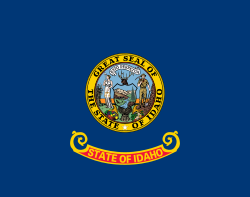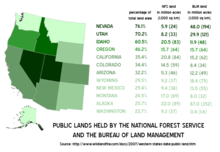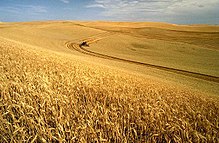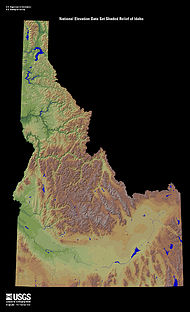| online and campus degrees |
|
| Degrees By Type |
|
| Degrees By Level |
|
| Degrees By Subject |
Degrees By Subject
|
|
||||||||||||||||||||||||||||||||||||||||||||||||||||||||||||||||||||||||||||||||||||||
| Idaho state symbols | |
|---|---|

The Flag of Idaho |
|

The Seal of Idaho |
|
| Living insignia | |
| Amphibian | Tiger salamander (Ambystoma tigrinum) |
| Bird |
|
| Fish | Cutthroat trout (Oncorhynchus clarkii) |
| Flower | Syringa (Philadelphus lewisii) |
| Horse breed | Appaloosa |
| Insect | Monarch butterfly (Danaus plexippus) |
| Tree | Western white pine (Pinus monticola) |
| Inanimate insignia | |
| Dance | Square dance |
| Food |
|
| Fossil | Hagerman horse (Equus simplicidens) |
| Gemstone | Star garnet |
| Slogan | Great Potatoes. Tasty Destinations. |
| Soil | Threebear |
| State route marker | |
 |
|
| State quarter | |

Released in 2007 |
|
| Lists of United States state symbols | |




Idaho prior to European settlement was inhabited by Native American peoples, some of whom still live in the area. In the early 19th century, Idaho was considered part of the Oregon Country, an area disputed between the U.S. and the United Kingdom. It officially became U.S. territory with the signing of the Oregon Treaty of 1846, but a separate Idaho Territory was not organized until 1863, instead being included for periods in Oregon Territory and Washington Territory. Idaho was eventually admitted to the Union on July 3, 1890, becoming the 43rd state.
Forming part of the Pacific Northwest (and the associated Cascadia bioregion), Idaho is divided into several distinct geographic and climatic regions. In the state's north, the relatively isolated Idaho Panhandle is closely linked with Eastern Washington, with which it shares the Pacific Time Zone – the rest of the state uses the Mountain Time Zone. The state's south includes the Snake River Plain (which has most of the population and agricultural land), while the south-east incorporates part of the Great Basin. Idaho is quite mountainous, and contains several stretches of the Rocky Mountains. The United States Forest Service holds about 38% of Idaho's land, the most of any state.
Industries significant for the state economy include manufacturing, agriculture, mining, forestry, and tourism. A number of science and technology firms are either headquartered in Idaho or have factories there, and the state also contains the Idaho National Laboratory, which is the country's largest Department of Energy facility. Idaho's agricultural sector supplies many products, but the state is best known for its potato crop, which comprises around one-third of the nationwide yield. The official state nickname is the "Gem State", which references Idaho's natural beauty[8].
Gross state product for 2015 was $64.9 billion,[52] and the per capita income based on 2015 GDP and 2015 population estimates was $39,100.[52][53]
Idaho is an important agricultural state, producing nearly one-third of the potatoes grown in the United States. All three varieties of wheat, dark northern spring, hard red, and soft white are grown in the state. Nez Perce County is considered a premier soft white growing locale.
Important industries in Idaho are food processing, lumber and wood products, machinery, chemical products, paper products, electronics manufacturing, silver and other mining, and tourism. The world's largest factory for barrel cheese, the raw product for processed cheese is in Gooding, Idaho. It has a capacity of 120,000 metric tons per year of barrel cheese and belongs to the Glanbia group.[54] The Idaho National Laboratory (INL) is the largest Department of Energy facility in the country by area. INL is an important part of the eastern Idaho economy. Idaho also is home to three facilities of Anheuser-Busch which provide a large part of the malt for breweries across the nation.
A variety of industries are important. Outdoor recreation is a common example ranging from numerous snowmobile and downhill and cross-country ski areas in winter to the evolution of Lewiston as a retirement community based on mild winters, dry, year-round climate and one of the lowest median wind velocities anywhere, combined with the rivers for a wide variety of activities. Other examples would be ATK Corporation, which operates three ammunition and ammunition components plants in Lewiston. Two are sporting and one is defense contract. The Lewis-Clark valley has an additional independent ammunition components manufacturer and the Chipmunk rifle factory until it was purchased in 2007 by Keystone Sporting Arms and production was moved to Milton, Pennsylvania. Four of the world's six welded aluminum jet boat (for running river rapids) manufacturers are in the Lewiston-Clarkston, WAvalley. Wine grapes were grown between Kendrick and Juliaetta in the Idaho Panhandle by the French Rothschilds until Prohibition. In keeping with this, while there are no large wineries or breweries in Idaho, there are numerous and growing numbers of award-winning boutique wineries and microbreweries in the northern part of the state.
Today, Idaho's largest industry is the science and technology sector. It accounts for over 25% of the state's revenue and over 70% of the state's exports. Idaho's industrial economy is growing, with high-tech products leading the way. Since the late 1970s, Boise has emerged as a center for semiconductor manufacturing. Boise is the home of Micron Technology, the only U.S. manufacturer of dynamic random-access memory (DRAM) chips. Micron at one time manufactured desktop computers, but with very limited success. Hewlett-Packard has operated a large plant in Boise since the 1970s, which is devoted primarily to LaserJet printers production.[55] Boise-based Clearwater Analytics is another rapidly growing investment accounting and reporting software firm, reporting on over $1 trillion in assets.[56] ON Semiconductor, whose worldwide headquarters in Pocatello, is a widely recognized innovator in modern integrated mixed-signal semiconductor products, mixed-signal foundry services, and structured digital products. Coldwater Creek, a women's clothing retailer, is headquartered in Sandpoint. Sun Microsystems (now a part of Oracle Corporation) has two offices in Boise and a parts depot in Pocatello. Sun brings $4 million in annual salaries and over $300 million of revenue to the state each year.

A number of Fortune 500 companies started in or trace their roots to Idaho, including Safeway in American Falls, Albertsons in Boise, JR Simplot across southern Idaho, and Potlatch Corp. in Lewiston. Zimmerly Air Transport in Lewiston-Clarkston was one of the five companies in the merger centered around Varney Air Lines of Pasco, Washington, which became United Airlines and subsequently Varney Air Group that became Continental Airlines.
The state personal income tax ranges from 1.6% to 7.8% in eight income brackets. Idahoans may apply for state tax credits for taxes paid to other states, as well as for donations to Idaho state educational entities and some nonprofit youth and rehabilitation facilities.
The state sales tax is 6% with a very limited, selective local option up to 6.5%. Sales tax applies to the sale, rental or lease of tangible personal property and some services. Food is taxed, but prescription drugs are not. Hotel, motel, and campground accommodations are taxed at a higher rate (7% to 11%). Some jurisdictions impose local option sales tax.
The sales tax was introduced at 3% in 1965, easily approved by voters,[57] where it remained until 1983.[58]
In 2014, Idaho emerged as the second most small business friendly state, ranking behind Utah, based on a study drawing upon data from over 12,000 small business owners.[59]
Idaho has a state gambling lottery which contributed $333.5 million in payments to all Idaho public schools and Idaho higher education from 1990 to 2006.[60]
The Idaho State Board of Education oversees three comprehensive universities. The University of Idaho in Moscow was the first university in the state (founded in 1889). It opened its doors in 1892 and is the land-grant institution and primary research university of the state. Idaho State University in Pocatello opened in 1901 as the Academy of Idaho, attained four-year status in 1947 and university status in 1963. Boise State University is the most recent school to attain university status in Idaho. The school opened in 1932 as Boise Junior College and became Boise State University in 1974. Lewis-Clark State College in Lewiston is the only public, non-university 4-year college in Idaho. It opened as a normal school in 1893.
Idaho has four regional community colleges: North Idaho College in Coeur d'Alene; College of Southern Idaho in Twin Falls; College of Western Idaho in Nampa, which opened in 2009, College of Eastern Idaho in Idaho Falls, which transitioned from a technical college in 2017.
Private institutions in Idaho are Boise Bible College, affiliated with congregations of the Christian churches and churches of Christ; Brigham Young University-Idaho in Rexburg, which is affiliated with The Church of Jesus Christ of Latter-day Saints and a sister college to Brigham Young University; The College of Idaho in Caldwell, which still maintains a loose affiliation with the Presbyterian Church; Northwest Nazarene University in Nampa; and New Saint Andrews College in Moscow, of reformed Christian theological background. McCall College is a non-affiliated 2-year private college in McCall, which was founded in 2011 and later opened in 2013.
- Boise Bible College
- Boise State University
- Brigham Young University-Idaho (formerly Ricks College)
- College of Idaho (formerly Albertson College of Idaho)
- College of Southern Idaho
- College of Western Idaho
- College of Eastern Idaho
- Idaho State University
- Lewis-Clark State College
- McCall College
- New Saint Andrews College
- North Idaho College
- Northwest Nazarene University
- University of Idaho
- "Idaho Statutes (73-121)". State of Idaho. 2017. Retrieved December 7, 2017.
- "Median Annual Household Income". The Henry J. Kaiser Family Foundation. Retrieved December 9, 2016.
- "Beauty Reset". NGS data sheet. U.S. National Geodetic Survey. Retrieved October 20, 2011.
- "Elevations and Distances in the United States". United States Geological Survey. 2001. Archived from the original on October 15, 2011. Retrieved October 21, 2011.
- Elevation adjusted to North American Vertical Datum of 1988.
- "Western States Data Public Land Acreage". Wildlandfire.com. November 13, 2007. Archived from the original on August 24, 2011. Retrieved July 30, 2010.
- "USDA Forest Service – Comment Form". Fs.fed.us. April 1, 2005. Retrieved July 30, 2010.
- Wells, Merle W. "Origins of the Name "Idaho" and How Idaho Became a Territory in 1863" (PDF). Retrieved January 16, 2019.
- Rees, John E (1928) [1868]. "Idaho – its meaning, origin and application". Internet Archive. Retrieved July 30, 2010.
- "Idaho". Encarta. MSN. Archived from the original on November 1, 2009.
- "Did Idaho Get Its Name As a Result of a Hoax?". Museum of hoaxes. April 25, 2006. Retrieved July 30, 2010.
- "Origins of the Name "Idaho" and How Idaho Became a Territory in 1863", Idaho Museum of Natural History (PDF), ISU .
- Barber; Martin (1956). Idaho in the Pacific Northwest. Caxton Printers; Library of Congress. 55-5192.
- "Idaho", Online Etymology Dictionary (dictionary) .
- "Port of Lewiston". US history. Retrieved July 30, 2010.
- "Sawtooth Range". Idaho climbing guide. Archived from the original on June 15, 2011. Retrieved July 30, 2010.
- "Part of Idaho in fourth zone". U.S. Code. Washington, D.C., U.S.: House of representatives. 264. Archived from the original on January 25, 2006.
- "Climate of Idaho". WRCC. DRI. February 20, 1954. Retrieved July 30, 2010.
- "Climate of Idaho". Western Regional Climate Center. Retrieved February 20, 2018.
- "Climate of Idaho". WRCC - DRI. February 20, 1954. Retrieved January 23, 2017.
- Weather Idaho, US travel weather, archived from the original on July 5, 2007 .
- "David Thompson's Trading Post". Idaho Forts. American Forts Network.
- Meinig, DW (1995) [1968]. The Great Columbia Plain. Weyerhaeuser Environmental Classic. University of Washington Press. pp. 36, 55. ISBN 978-0-295-97485-9.
- "Fur Trade Posts In Idaho" (PDF). Idaho State Historical Society.
- "Donald MacKenzie's Post". Idaho Forts. American Forts Network.
- Bennett, Eldon T. "An Early History of Franklin". Franklin, ID. Retrieved May 19, 2008.
- "Elias Davidson Pierce and the Founding of Pierce" (PDF). Idaho State Historical Society. August 1966. Retrieved May 19, 2008.
- "Territorial Government in Idaho, 1863–1869" (PDF). Reference. ID, US: State Historical Society. 1968. Archived from the original (PDF) on October 2, 2013. Retrieved September 29, 2013.
- Tanenhaus, David S. "Mormon" (PDF). The Encyclopedia of the Supreme Court of the United States (entry). Retrieved July 30, 2010.
- "Idaho becomes 43rd state - Jul 03, 1890 - HISTORY.com". HISTORY.com. Retrieved February 2, 2018.
- Schwantes, Carlos (1991). In Mountain Shadows: a History of Idaho. Lincoln: University of Nebraska Press.
- Doyle, Randall (2004). A political dynasty in North Idaho, 1933–1967. University Press. p. 7. ISBN 978-0-7618-2842-6.
- "The Power of Idaho" (whitepaper). ID: Economic Development Association. 2004. Archived from the original on October 13, 2007. Retrieved October 7, 2007.
- Resident Population Data (January 7, 2015). "Resident Population Data – 2010 Census". 2010.census.gov. Archived from the original on October 28, 2011. Retrieved January 7, 2015.
- "QuickFacts Idaho; UNITED STATES". 2018 Population Estimates. United States Census Bureau, Population Division. March 10, 2019. Retrieved March 10, 2019.
- "Idaho". QuickFacts. US: Census Bureau. Archived from the original on June 23, 2012. Retrieved July 30, 2010.
- "2016 American Community Survey - Demographic and Housing Estimates". United States Census Bureau. Retrieved November 21, 2018.
- Historical Census Statistics on Population Totals By Race, 1790 to 1990, and By Hispanic Origin, 1970 to 1990, For The United States, Regions, Divisions, and States Archived July 25, 2008, at the Wayback Machine
- "Idaho :: Census Viewer :: CensusViewer :: Powered by Moonshadow Mobile". Idaho.us.censusviewer.com. Retrieved September 4, 2017.
- Center for New Media and Promotions(C2PO). "2010 Census Data". Census.gov. Retrieved September 4, 2017.
- "2016 American Community Survey - Selected Social Characteristics". United States Census Bureau. Retrieved November 21, 2018.
- "Births: Final Data for 2013" (PDF). Cdc.gov. Retrieved September 4, 2017.
- "Births: Final Data for 2014" (PDF). Cdc.gov. Retrieved September 4, 2017.
- "Births: Final Data for 2015" (PDF). Cdc.gov. Retrieved September 4, 2017.
- "Religious Landscape Study". May 11, 2015.
- "Religious Landscape Study, february 2008" (PDF). Pew Research Center. Archived from the original (PDF) on April 17, 2017. Retrieved April 12, 2017.
- "Religious Landscape Study". Pew Research Center. Retrieved April 12, 2017.
- "About the Religious Landscape Study". Pew Research Center. Retrieved April 12, 2017.
- "State Membership Report". Data Archives. The Arda. 2010. Retrieved November 12, 2013.
- "Gross domestic product (GDP) by state (millions of current dollars)". U.S. Bureau of Economic Analysis. U.S. Department of Commerce. Archived from the original on December 30, 2017. Retrieved March 9, 2018.
- "QuickFacts Idaho". United States Census Bureau. U.S. Department of Commerce. Retrieved July 12, 2016.
- Zuivelzicht, April 25, 2007 .
- "Today in History: March 4". Memory. Washington, D.C., US: Library of Congress. Retrieved July 30, 2010.
- "About Clearwater". 2014.
- "Conservatism given credit by Samuelson". Spokesman-Review. Associated Press. November 10, 1966. p. 1.
- "Sales tax rate history". State of Idaho. Retrieved June 11, 2013.
- "Facts At a Glance". Idaho Lottery. 2007. Archived from the original on June 13, 2007. Retrieved April 29, 2007.
- "2007 Idaho Energy Plan" (PDF). Idaho Legislative Council Interim Committee on Energy, Environment and Technology. 2007. Retrieved November 30, 2010.
- "Idaho Energy Profile". Energy Information Administration. 2009. Archived from the original on February 2, 2007. Retrieved June 2, 2007.
- "Idaho Strategic Energy Alliance Frequently Asked Questions" (PDF). Idaho Strategic Energy Alliance. 2009. Archived from the original (PDF) on April 16, 2009. Retrieved June 2, 2007.
- "FAQ". Idaho Energy Complex. 2009. Retrieved June 2, 2007. [permanent dead link]
- "Renewable Energy Technical Potential", GIS, NREL, archived from the original on September 15, 2012 .
- US Installed Wind Capacity, Wind powering America, archived from the original on March 14, 2014 .
- EIA (July 27, 2012). "Electric Power Monthly Table". United States Department of Energy. 1.17.A. Retrieved August 15, 2012.
- EIA (July 27, 2012). "Electric Power Monthly Table". United States Department of Energy. 1.17.B. Retrieved August 15, 2012.
- Sherwood, Lawrence 'Larry' (June 2011). "U.S. Solar Market Trends 2010" (PDF). Interstate Renewable Energy Council (IREC). Retrieved June 29, 2011.
- Sherwood, Lawrence 'Larry' (August 2012). "U.S. Solar Market Trends 2011" (PDF). Interstate Renewable Energy Council (IREC). Archived from the original (PDF) on September 6, 2012. Retrieved August 16, 2012.
- "FAQ". ITD. 2007. Retrieved April 22, 2007. The transportation department also oversees federal grants to 15 rural and urban public transportation systems, provides state rail planning and rail-project development and supports bicycle and pedestrian projects.
- "Major Airports in Idaho". Traveltips.usatoday.com. Retrieved September 4, 2017.
- "Constitution of the State of Idaho" (PDF). History.idaho.gov. Archived from the original (PDF) on May 25, 2017. Retrieved September 4, 2017.
- "Idaho District Court Websites". ID: ISC. Archived from the original on December 16, 2008. Retrieved December 17, 2008.
- "Pierce". Idaho History. July 7, 2010. Retrieved July 30, 2010.
- "Voter Registration Totals as of May 3, 2018". Idaho Department of State.
- "Capitol Move or Theft? – Essays – Capitol of Light (Idaho Public Television)". Idahotv.org. Retrieved September 4, 2017.
- General Election Results, ID: Secretary of State Election Division, November 4, 2008, archived from the original on December 15, 2008 .
- "ID", Elections 1 998 (profile), NCSL, 2006, archived from the original on May 1, 2009
- "Statewide totals", Election (results), ID: State government, 2008, archived from the original on February 20, 2015
- "Population Estimates". Archived from the original on October 19, 2016.
- Engber, Daniel. "Who Made That Ski Lift?". New York Times Magazine. New York Times. Retrieved December 19, 2015.
- "United States High School Boys Rankings | Outdoor Track And Field All-Time800 Meter Run". MileSplit United States. Retrieved April 11, 2016.
- "State Symbols". ID: Secretary of State. Archived from the original on March 13, 2012. Retrieved April 2, 2012.
- "Reference" (PDF). Idaho history. July 7, 2010. Retrieved July 30, 2010.
- "Star Is Born, A (1954) – (Movie Clip) Born In A Trunk". Turner Classic Movies. Turner. Retrieved December 18, 2015.
- "Eastwood film gives boost". Spokane Chronicle. Washington. Associated Press. November 30, 1984. p. 12.
- Metter, Alan (March 4, 1988), Moving, Richard Pryor, Beverly Todd, Stacey Dash, retrieved October 30, 2017
- Robb, Brian J (1995). "River Phoenix: A Short Life". Perennial.
- Greenberg, Harvey (Fall 1992). "My Own Private Idaho". Film Quarterly.
- Berg, Tyler (June 27, 2014). "A look at Preston 10 years after 'Napoleon Dynamite'". KIFI. Retrieved January 28, 2018.
Online Business or e-business is any kind of business or commercial transaction that includes sharing information across the internet. Commerce constitutes the exchange of products and services between businesses, groups and individuals and can be seen as one of the essential activities of any business. Electronic commerce focuses on the use of ICT to enable the external activities and relationships of the business with individuals, groups and other businesses, while e-business refers to business with help of the internet. The term "e-business" was coined by IBM's marketing and Internet team in 1996.
E-commerce (short for "electronic commerce") is trading in products or services using computer networks, such as the Internet. Electronic commerce draws on technologies such as mobile commerce, electronic funds transfer, supply chain management, Internet marketing, online transaction processing, electronic data interchange (EDI), inventory management systems, and automated data collection. Modern electronic commerce typically uses the World Wide Web for at least one part of the transaction's life cycle, although it may also use other technologies such as e-mail.
E-business systems naturally have greater security risks than traditional business systems, therefore it is important for e-business systems to be fully protected against these risks. A far greater number of people have access to e-businesses through the internet than would have access to a traditional business. Customers, suppliers, employees, and numerous other people use any particular e-business system daily and expect their confidential information to stay secure. Hackers are one of the great threats to the security of e-businesses. Some common security concerns for e-Businesses include keeping business and customer information private and confidential, authenticity of data, and data integrity. Some of the methods of protecting e-business security and keeping information secure include physical security measures as well as data storage, data transmission, anti-virus software, firewalls, and encryption to list a few.
A Bachelor of Information Technology (abbreviations BIT, BInfTech, B.Tech(IT) or BE(IT)) is an undergraduate academic degree that generally requires three to five years of study. While the degree has a major focus on computers and technology, it differs from a Computer Science degree in that students are also expected to study management and information science, and there are reduced requirements for mathematics. A degree in computer science can be expected to concentrate on the scientific aspects of computing, while a degree in information technology can be expected to concentrate on the business and communication applications of computing. There is more emphasis on these two areas in the e-commerce, e-business and business information technology undergraduate courses. Specific names for the degrees vary across countries, and even universities within countries.
This is in contrast to a Bachelor of Science in Information Technology which is a bachelor's degree typically conferred after a period of three to four years of an undergraduate course of study in Information Technology (IT). The degree itself is a Bachelor of Science with institutions conferring degrees in the fields of information technology and related fields.
We are currently negotiating for a listing.
Please bookmark us and check back soon!
| Alabama | Massachusetts | Ontario |
| Arizona | Winnepeg, MB | Oregon |
| Vancouver, BC | Maryland | Pennsylvania |
| California | Michigan | Puerto Rico |
| Colorado | Missouri | Tennessee |
| Connecticut | Mississippi | Texas |
| Florida | New Jersey | Utah |
| Georgia | New Mexico | Virginia |
| Hawaii | Nevada | Washington |
| Idaho | New York | Wisconsin |
| Illinois | Ohio | Online Programs |
| Louisiana | Oklahoma | |
Industry Description
e-Business Degrees
Idaho Listing
The e-Business Program blends business and information technology to address the emerging field of e-Commerce and e-Business. This program was developed to further enhance existing core competencies and skill sets, applying the traditional business models to the virtual marketplace.
The curriculum is designed to produce graduates ready to function in e-Business positions with the competencies, skills, and attitudes necessary for success in the workplace.
Degrees By Subject
![]()
Computer Colleges
CAD Schools
Computer Animation Universities
Computer Networking Courses
Computer Programming Colleges
Computer Science Degrees
Electronics Courses
Internet Computer Classes
Online CAD Programs
Online Computer Certification
Online Computer Science Degree
Online Programming Classes
Programming Degrees
Healthcare Training
Dental Assisting Schools
Dental Colleges
Dental Hygenist Program
HIPAA Schools
Massage Therapy Classes
Medical Administration
Medical Assistant Training
Medical Billing And Coding Courses
Nursing Classes
Nursing Courses Online
Online Health Care Degrees
Phlebotomist Certification
Physical Therapy Colleges
Ultrasound Schools
Ultrasound Technician Training
Culinary & Hospitality Training
Baking School
Cooking Courses
Culinary Arts Programs
Hotel Management Schools
Pastry Class
Restaurant Management Schools
Travel Colleges
Legal Training
Criminal Justice Degree Online
Criminal Justice Courses
Legal Assistant Training
Online Paralegal Courses
Paralegal Courses
Teacher Colleges
Education Colleges
Education Degree Online
Teacher Certification Online
Teacher Training Schools
Film & Journalism Schools
Broadcasting Training
Film Degree
Journalism Courses
Movie Schools
Photography Courses
Video Production Courses
Criminal Justice
Criminal Justice Degree Online
Criminal Justice Courses
Legal Assistant Training
Paralegal Courses
Online Paralegal Courses
Site Map
Idaho ID e-Business Sponsors
| Technical and Non-Technical Degrees | Chubb Institute | DeVry University | University of Phoenix | DeVry Keller University | College Searching
College Searching Sponsors
debt consolidation | University Online Degree | Home Remodeling | debt help | General Links |
College Searching and Online Degrees offer Associate, Bachelor, Masters and Ph.D. degrees in automotive, teaching, finance, internet technology, accounting, marketing, Idaho ID e-Business, nursing, computer science, fashion and graphic design, and much more!
©1998-2025 College Search, Inc. |
™Online & Campus Degrees Directory |






